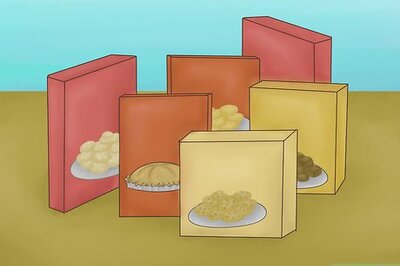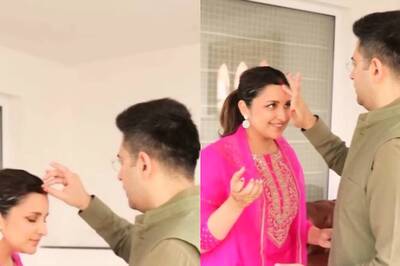
views
Objective
The object is to be the first player to get rid of all your cards. Continue to play hands until one of the players reaches 500 points. Instead of playing to 500 points, which can make the game run long, some players like to set a time limit and total the scores once their time is up. Whoever has the lowest score at the end of the game wins.
Rules
Play cards based on the rank of the card, not its suit. If you play 4 of the same rank cards, this is called a swoop, and you remove the stack of cards under the 4 matching cards from gameplay. If you swoop a pile, continue your turn by playing any available card. If you can’t match 4 cards, play a card with a lower rank, ending your turn. Play any of the face-up cards in front of you or cards in your hand as long as the ranks match. You can’t play a mystery card (facedown in front of you) until you play the face-up card covering it. You may not look at any mystery card before you play it. 10s and Jokers are SWOOP cards. Use them to swoop a pile at any time without matching 4 cards.
Setting Up the Game
Place all cards facedown and shuffle to mix the decks. Since you’re playing with multiple card decks, shuffling them all at once may be difficult. Randomly split each deck and shuffle it with part of a different deck until you thoroughly mix the cards. Alternatively, wash the decks together by spreading them out on the table and swishing them around with your hands until they’re well shuffled. Swoop is played with Jokers, so don’t remove them from the decks.
Each player draws 19 facedown cards to make their hand and draw piles. Once the cards are picked, set the remaining cards aside. You won’t use them to play the hand. Have each player place 4 cards facedown in a line on the table in front of them. Have them place 4 more cards face up on each of the 4 facedown cards. Each player has 11 cards remaining. The cards make up their hand.
Scoring
Traditional Scoring In traditional Swoop scoring, number cards each count as their rank value, with face cards and SWOOP cards worth more. Aces count as 1 point. Face cards are 10 points each All other cards count at face value Tens and Jokers are SWOOP cards and are worth 50 points each
Beginner Scoring Beginner scoring is the same as traditional scoring, except the Aces and all the number cards are worth 5 points each. This makes it easier to total scores, especially when playing with young children.
Playing the Game
Choose which player will take the first turn by drawing cards. Each player selects a card from the unused pile you set aside. Whoever picks the highest card goes first. The player to their left plays second, and so on, around the table.
Start by playing matching cards from your hand or face-up cards. Play any number of cards with a matching rank to the middle of the table. As you play the cards, call out what you’re playing. For example, if you play three Kings, say, “Three Kings,” as you lay the cards in the center of the table. If you play 4 matching cards, swoop them to the side and begin again. This is only recommended in the first round if you have 4 high face cards since they have higher point values. If you can only play 2 or 3 matching cards, announce the play, and your turn is over.
The player to your left must match the rank of the cards you played. Using the cards in their hand and the face-up cards on the table in front of them, they try to use the cards you played to complete a swoop. For example, if you played two 7s, the next player can finish the swoop and remove the cards from the table by playing two more 7s. If the player can’t finish the swoop, they can play any card of the same rank or lower to end their turn. For example, if there are two 7s on the table, they can play a 7 or lower (Ace through 6). If they have a 10 or a Joker, they can play it to swoop the pile to continue their turn until they can no longer swoop a pile. Players who can’t complete a swoop by matching 4 cards or playing a swoop card must play a higher-ranked card.
Each player takes a turn, trying to match as many cards as possible. If they don’t have any matches, they must play another card. If they don’t have a match, swoop card, or a lower-value card than the number played, they must play a higher-value card and add the pile to their hand instead of removing it from play. For example, there is a pile with two 4 cards on the top. You don’t have any 4s, 3s, 2s, Aces, 10s, or Jokers, so you must play any card from your hand or the face-up cards and pick up the cards in the pile. If you have previously uncovered one of the mystery cards by playing the face-up card on top of it, you can choose to play the mystery card, but you can’t look at it first.
Strategies to Win
Organize the cards in your hand by rank. Mixing multiple decks and setting most of the cards aside means winning Swoop can truly depend on the luck of the draw, but organizing your hand can help you keep track of the cards you have. An organized hand also makes it easier for you to play cards strategically since you know how many cards of each rank you have. Take a moment to put your cards in rank order, starting with Kings and working your way down to Aces. Pull out the Jokers and 10s and place them together on one side of your hand so you know how many SWOOP cards you have at a glance.
Get rid of high-point cards as soon as possible. Face cards have higher point values than the Ace through 9 cards. Because the object of the game is to end the hand with the fewest number of points, try to play Kings, Queens, and Jacks as quickly as possible. Though the SWOOP cards (10s and Jokers) are worth 50 points each – the highest point cards in the game – hold on to them and use them as needed. If another player is low on cards and you still have several SWOOP cards in your hand, try to play them as soon as possible so you don’t get stuck with them at the end of the round.
Play as many matching cards as you can. While it’s possible to only play some of your matching cards, it’s usually best to play as many cards as possible in each turn. This is especially true if you have matching face cards with high point values. It’s often better to play fewer matching face cards than more lower-point cards. For example, if your hand is 2 Kings, 1 Queen, 2 Jokers, four 3s, and a 2, play the two Kings before the four 3s if you can, since the Kings are worth 20 points and the 3s are worth 12 points using traditional scoring. However, you don’t have to play all of your matches of a rank in a single turn. Bluff by only playing some of your matching cards or none at all to mislead other players. For example, you only need two 8s to complete a swoop, but you have 3. You can play all 3 or only 2.
Don’t play the low-point cards too early in the game. If you’re dealt several Aces or 2s, consider keeping a few of them to play later in the game. Because of their low point value, they’re low-risk cards to keep in your hand if another player plays all of their cards. Watch for players who no longer have low-point cards. If you can play an Ace or 2, you may force the other player to pick up the pile because they can’t match or lay a lower-ranked card.
Play mystery cards when only a few cards are in the pile. Since you don’t know what the value of the mystery card is, it can be risky to play. Try to play one of these cards when there are very few cards in the pile, so you won’t have many to pick up if the mystery card is higher than the top cards in the pile.


















Comments
0 comment